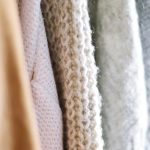Hemming knit fabric is like mastering different stitches in a tapestry, adding depth and structure to your creations. You seek to refine your craft and elevate the finish of your knit garments.
In this guide, you will learn five essential techniques for hemming knit fabric. These methods will empower you to create professional-looking hems that maintain the stretch and elasticity of your knit fabric while ensuring durability and aesthetics.
Whether you're working with lightweight jersey or heavy sweater knits, mastering these hemming techniques will enhance the quality and longevity of your handmade garments.
Let's dive into the art of hemming knit fabric with precision and skill.
Key Takeaways
- Folded Hem: Achieved through rolled hem or serger hem methods, ideal for lightweight or delicate knits, helps prevent curling of fabric edges.
- Twin Needle Hem: Requires a twin needle for sewing two parallel lines of stitching, adjust machine tension and stitch length to prevent puckering or loops, choose needle size based on fabric weight, test tension and stitch length on scrap fabric before starting.
- Coverstitch Hem: Creates parallel rows of stitching on top with looper thread interlacing on the back, maintains stretch and flexibility of the fabric, efficient and time-saving for hemming, versatile for decorative stitching and attaching trims.
- Stretch Blind Hem: Utilize a specialized presser foot for creating a stretch blind hem, set sewing machine to blind hem stitch, fold and press fabric edge for a crisp hemline, maintains fabric stretch while creating an invisible hem.
Folded Hem
You'll often need to create a folded hem when hemming knit fabric. A folded hem can be achieved through two main methods: the rolled hem, which is typically hand-sewn, and the serger hem, which offers a decorative finish.
To create a rolled hem, fold the raw edge of the fabric over by a small amount, then fold it over again to encase the raw edge. This creates a neat and secure hem, and when done by hand, allows for meticulous control over the stitching. It's an ideal choice for lightweight or delicate knits where a visible hem may be undesirable.
On the other hand, a serger hem is created by using a serger machine that trims the edge of the fabric while overcasting the raw edge to prevent fraying. This method not only finishes the edge but also provides a decorative touch. It's particularly useful for knit fabrics with a tendency to curl at the edges, as the serger hem helps to keep the fabric flat and prevents curling.
Both methods result in a professional-looking folded hem, catering to different preferences and fabric types.
Twin Needle Hem
To create a professional-looking twin needle hem on knit fabric, you'll need a twin needle, which is designed to sew two parallel lines of stitching simultaneously. When using a twin needle, it's crucial to adjust your machine's tension to prevent the formation of puckers or loops.
Set your machine to a straight stitch and choose a twin needle that suits the weight of your fabric. The needle size should correspond to the fabric weight; for lighter knits, use a smaller needle, and for heavier knits, choose a larger one.
Before starting, test the tension and stitch length on a scrap of your fabric to ensure the twin needle creates a flat, even hem. You may need to decrease the upper tension slightly to accommodate the use of two threads. Additionally, adjusting the stitch length can help prevent any stretching or tunneling in the hem.
When selecting thread, consider using a quality polyester thread or wooly nylon for stretch fabrics to ensure durability and flexibility.
Following these guidelines will help you achieve a professional-looking twin needle hem on your knit fabric.
Coverstitch Hem
After you have mastered the twin needle hem, you can explore creating a professional coverstitch hem on knit fabric. Utilizing a coverstitch machine allows for a high-quality, stretchable finish that's commonly found on store-bought knit garments.
Here are some key points to consider when using a coverstitch machine for hemming techniques:
- Professional Finish: The coverstitch machine creates parallel rows of stitching on the top with a looper thread interlacing between the rows on the back, resulting in a neat and professional finish.
- Stretch and Flexibility: Unlike traditional straight stitches, the coverstitch allows the hem to maintain its stretch and elasticity, making it ideal for knit fabrics that require flexibility.
- Efficient and Time-Saving: The coverstitch machine is designed specifically for hems and provides efficient, fast results, saving you time and effort.
- Versatility: Apart from hems, the coverstitch machine can also be used for decorative stitching, attaching trims, and constructing garments, adding to its versatility in sewing projects.
Mastering the coverstitch hemming technique will elevate the quality of your knit fabric projects, providing durability and a professional touch.
Stretch Blind Hem
To achieve a stretch blind hem on knit fabric, consider utilizing a specialized presser foot designed for creating this type of hem. This presser foot helps in folding and stitching the fabric edge to create a clean, professional-looking hem.
Before starting, ensure that your sewing machine is set to a blind hem stitch. Fold the fabric edge and press it with an iron to create a crisp, defined hemline.
Then, align the fabric edge with the guide on the presser foot and start stitching. As you sew, the presser foot will slightly stretch the fabric, allowing it to retain its stretchiness while creating an almost invisible hem on the right side of the fabric.
This technique is particularly useful for knit fabrics, as it maintains the fabric's stretch while providing a neat finish.
Practice this method on scrap fabric to perfect your technique before hemming your actual garment.
With these hemming techniques and sewing tips, you can achieve professional-looking hems on stretchy knit fabrics with ease.
Rib Knit Hem
You can achieve a professional-looking rib knit hem by using a specialized presser foot and a stretch stitch on your sewing machine. When working with stretchy rib knit, it's essential to use the right hemming techniques to ensure a clean and polished finish.
- Choose the right needle: Opt for a ballpoint or stretch needle to prevent skipped stitches and fabric damage.
- Use a walking foot: This will help feed the fabric evenly and prevent stretching or distortion while sewing.
- Test your stitch length and tension: Make sure to do a few test runs on a scrap of fabric to determine the ideal settings for your specific rib knit.
- Press as you sew: Use a low-heat iron and a pressing cloth to gently press the hem as you sew, ensuring a professional finish.
Frequently Asked Questions
Can I Use the Same Technique to Hem Both Lightweight and Heavyweight Knit Fabrics?
Yes, you can use the same hemming techniques for lightweight and heavyweight knit fabrics. Adjust stitch length based on fabric weight. For lightweight knits, consider using a narrow zigzag stitch, while for heavyweight knits, a wider zigzag stitch works well.
What Type of Thread Is Best for Hemming Knit Fabric?
For hemming knit fabric, the best type of thread is a stretchy or elastic thread. This thread is suitable for knit fabric because it allows the hem to stretch without breaking the thread.
Are There Any Special Considerations When Hemming Stripes or Patterned Knit Fabric?
When hemming patterned knits, consider matching the pattern at the seam. Use stretchy hems and adjust your sewing techniques to accommodate the pattern. Follow these hemming tips for a professional finish on your knit fabric.
How Do I Prevent the Hem From Puckering or Stretching Out When Sewing Knit Fabric?
To prevent puckering and maintain stretch when sewing knit fabric, use a stretch stitch or twin needle. Match fabric weight with needle and thread. Align patterns carefully and use a walking foot for a professional finish.
Can I Use a Regular Sewing Machine to Create a Professional-Looking Hem on Knit Fabric, or Do I Need a Special Machine?
You can use a regular sewing machine for a professional-looking hem on knit fabric. Use a stretch stitch and a ballpoint needle to prevent puckering and stretching. For lightweight knits, consider a twin needle. No special machine needed.
- Tetron Fabric for Marine Applications: Durability and Use Cases - June 18, 2025
- Tetron Fabric for Outdoor Furniture: Weather Resistance and Care - June 18, 2025
- Tetron Fabric for Wall Coverings: Style and Application Tips - June 18, 2025







